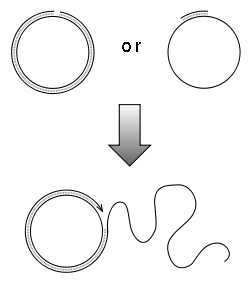Rolling circle
- Rolling circle
-
Réplication circulaire de l´ADN

La réplication circulaire produit plusieurs copies d´une matrice circulaire.
La réplication de type Rolling circle est un processus de duplication d´acide nucléiques ADN ou ARN donnant plusieurs copies de molécules circulaires d´ADN ou ARN. Ce type de réplication est utilisé pour la duplication de certains plasmides et génome de bactériophages, viroides possédant un génome ARN et quelques virus infectant des cellules eucaryotes.
Réplication circulaire de l´ADN
Chez la bactérie, La réplication circulaire de l´ADN est initiée par une protéine initiatrice codée par un plasmide ou bien un bactériophage qui va créer une coupure simple brin au niveau de ce que l´on appelle l´origine double brin (doudle-strand origin ou DSO en anglais). La protéine initiatrice reste associée à l´extrémité 5´phosphate du brin coupé alors que l´extrémité 3´OH est libérée pour servir d`amorce pour la synthèse d´ADN par l´ADN polymérase de type III. En utilisant le brin non coupé comme matrice, la réplication de l´ADN s´éffectue le long de la molécule d´ADN circulaire déplaçant le brin coupé simple brin. Le déplacement du brin coupé simple brin est réalisé par une hélicase appelée PcrA (Plasmid copy reduced A) exprimée par la cellule hôte. La synthèse continue d´ADN peut générer plusieurs copies simples brins de la molécule d´ADN originale arrangées en concatémère. Ces copies linéaires peuvent être converties en molécules doubles brins. Pour cela, la protéine initiatrice génère une nouvelle coupure simple brin pour terminer la synthèse circulaire du brin direct (leading strand en anglais), cette coupure est appelée origine simple brin (single-stranded origin ou SSO). Ensuite, une primase synthètise une amorce ARN qui sert à initier la duplication de l´ADN par une ADN polymérase de type II. Une fois l´amorce ARN remplacée par de l´ADN, une ADN ligase va lier les extrémites pour former une molécule d´ADN double brin.
Ce type de réplication est utilisé en biotechnologie pour amplifier des petites quantités d´ADN in vitro.
Voir aussi
Liens externes
 Portail de la biologie cellulaire et moléculaire
Portail de la biologie cellulaire et moléculaire
Catégories : Réplication de l'ADN | Biologie cellulaire | ADN | Génétique
Wikimedia Foundation.
2010.
Contenu soumis à la licence CC-BY-SA. Source : Article Rolling circle de Wikipédia en français (auteurs)
Regardez d'autres dictionnaires:
Rolling circle replication — describes a process of nucleic acid replication that can rapidly synthesize multiple copies of circular molecules of DNA or RNA, such as plasmids, the genomes of bacteriophages, and the circular RNA genome of viroids. Some eukaryotic viruses also … Wikipedia
Rolling circle of a paddle wheel — Rolling Roll ing, a. 1. Rotating on an axis, or moving along a surface by rotation; turning over and over as if on an axis or a pivot; as, a rolling wheel or ball. [1913 Webster] 2. Moving on wheels or rollers, or as if on wheels or rollers; as,… … The Collaborative International Dictionary of English
rolling circle model — rolling circle model. См. репликация σ типа. (Источник: «Англо русский толковый словарь генетических терминов». Арефьев В.А., Лисовенко Л.А., Москва: Изд во ВНИРО, 1995 г.) … Молекулярная биология и генетика. Толковый словарь.
Rolling-Circle-Replikation — DNA Replikation. Die Doppelhelix wird durch die Helicase und die Topoisomerase geöffnet. Danach setzt die Primase einen Primer und die … Deutsch Wikipedia
Rolling circle replication — DNA Replikation. Die Doppelhelix wird durch die Helicase und die Topoisomerase geöffnet. Danach setzt die Primase einen Primer und die … Deutsch Wikipedia
rolling circle — noun 1. : the generating circle of cycloidal and similar curves 2. : pitch circle … Useful english dictionary
rolling-circle mechanism — A mode of DNA replication in which the replication fork moves around a circular DNA molecule, displacing a strand to give a tail that is also copied to produce a new double stranded DNA … Dictionary of microbiology
rolling circle mechanism — A mechanism of DNA replication in many viral DNAs, in bacterial F factors during mating, and of certain DNAs in gene amplification in eukaryotes. DNA synthesis starts with a cut in the + strand at the replication origin, the 5 end rolls out and… … Dictionary of molecular biology
Rolling — Roll ing, a. 1. Rotating on an axis, or moving along a surface by rotation; turning over and over as if on an axis or a pivot; as, a rolling wheel or ball. [1913 Webster] 2. Moving on wheels or rollers, or as if on wheels or rollers; as, a… … The Collaborative International Dictionary of English
Rolling bridge — Rolling Roll ing, a. 1. Rotating on an axis, or moving along a surface by rotation; turning over and over as if on an axis or a pivot; as, a rolling wheel or ball. [1913 Webster] 2. Moving on wheels or rollers, or as if on wheels or rollers; as,… … The Collaborative International Dictionary of English

